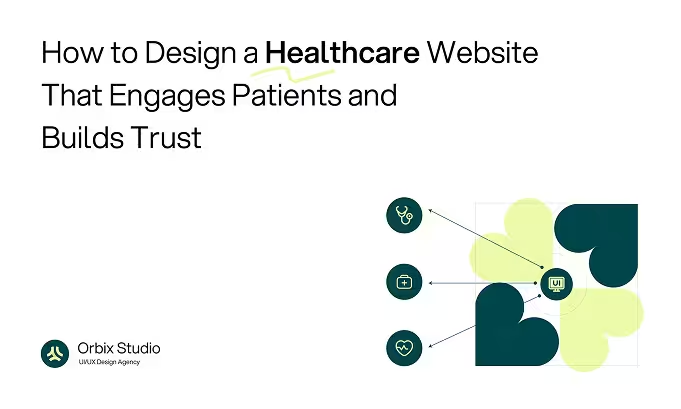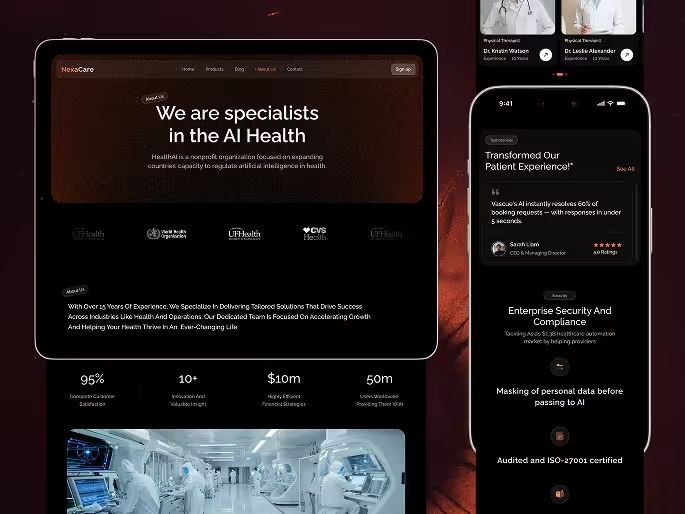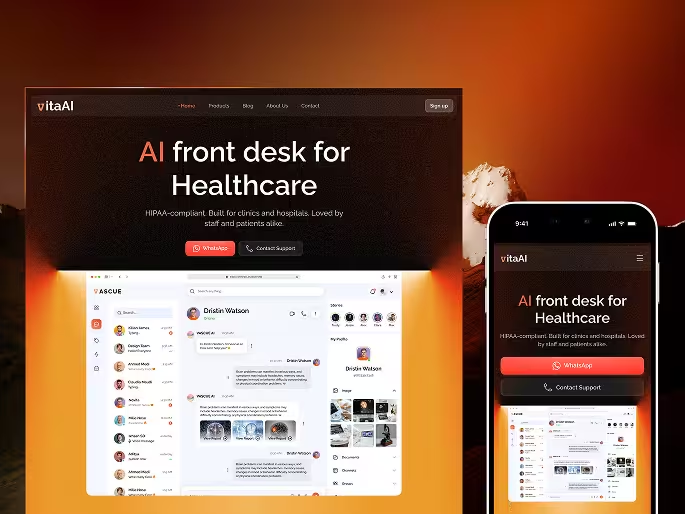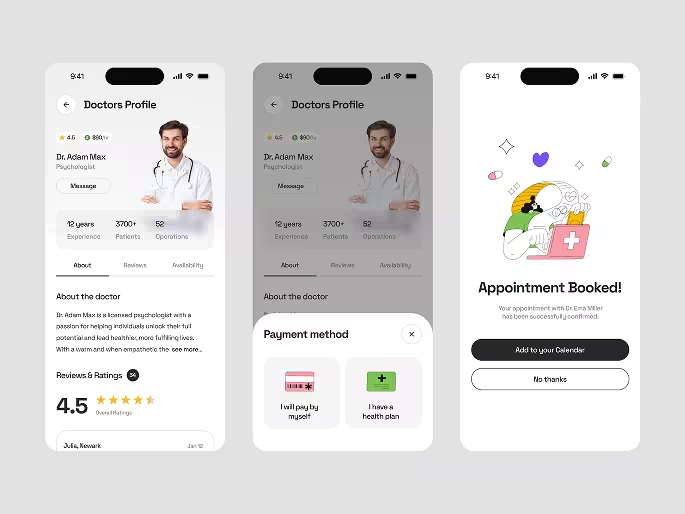Table of Contents
- Aligning Patient Needs With Business and Clinical Goals
- Research Driven Design Based on Real Patient Behavior
- Information Architecture That Simplifies Complex Medical Content
- Content Strategy and UX Writing That Build Trust
- Visual Design Systems
- Accessibility and Inclusive Design for All Patients
- Best Healthcare Website Designs
- Conclusion

A healthcare website is no longer simply an online brochure. It has become a critical part of the patient journey and a powerful driver of trust, credibility, and long term engagement. Patients search for symptoms, evaluate providers, compare clinics, and book appointments online. If your healthcare website does not meet modern usability expectations, patients quickly lose confidence and switch to a facility that offers a better digital experience.

As a UI UX design agency specializing in healthcare design, we view medical websites as a blend of service design, emotional design, and usability engineering. Our goal is not only to create visually appealing interfaces but to build patient trust, simplify complex medical journeys, and support measurable business outcomes such as higher appointment booking rates, increased portal adoption, and stronger patient retention.
Aligning Patient Needs With Business and Clinical Goals
The foundation of an effective healthcare website begins with aligning three core elements. Patients want clarity, reassurance, and easy access to care. Healthcare providers want efficiency, lower administrative workload, and improved patient satisfaction. Clinical teams require accuracy and responsible communication. An effective healthcare website bridges all three by translating clinical expertise into clear digital experiences that patients can understand and act upon.
Before the design phase begins, we identify digital success metrics such as appointment completion rate, search success rate, reduction in call center dependency, and improved patient portal engagement. These benchmarks guide every design decision and help ensure that the final product supports both patient needs and healthcare business goals.
Research Driven Design Based on Real Patient Behavior
Good healthcare design starts with understanding the real world challenges that users face. Through patient interviews, surveys, analytics reviews, and market audits, we uncover the motivations and fears that shape digital behavior. Many patients are anxious, confused, or overwhelmed when they visit a healthcare website. They may be dealing with symptoms, time pressure, or emotional stress. This context influences everything from the tone of the content to the flow of appointment scheduling.
We also interview doctors, nurses, administrative teams, and medical coordinators to understand their workflows. The website must support internal operations as seamlessly as it supports patient needs. Research allows us to design systems that reduce unnecessary phone calls, prevent booking errors, and improve communication between patients and providers.
Mapping the Patient Journey to Remove Friction

Once research is complete, we map the entire digital patient journey. The journey begins with a patient searching for symptoms or services online. It continues with reading about doctors, understanding treatment options, checking insurance details, and booking appointments. After becoming a patient, the journey extends to viewing test results, managing prescriptions, and receiving follow up reminders through the patient portal.
This journey is often filled with friction when websites are poorly designed. Confusing navigation, unclear instructions, slow loading pages, and complicated forms create stress. Our work is focused on removing these obstacles and guiding the user step by step. Each stage of the journey must be supported with precise content, intuitive layout, and a calming design approach that reduces cognitive load.
Information Architecture That Simplifies Complex Medical Content

Healthcare content is naturally complex. Conditions, symptoms, procedures, and insurance rules can confuse an average patient. This is where information architecture becomes critical. As a UI UX agency, we reorganize medical content into clear, predictable categories that patients understand immediately. We create simple navigation labels, logical content hierarchies, and effective search systems that help patients find information without feeling overwhelmed.
Our information architecture work includes search models, tagging systems, structured service pages, and doctor databases that allow patients to filter by specialty, experience, insurance coverage, and location. When content is well organized, patients stay longer on the website and trust the provider more.
Content Strategy and UX Writing That Build Trust
In healthcare, content is part of the user experience. Heavy clinical terminology can intimidate users, so we transform medical language into clear, friendly, patient focused wording while respecting clinical accuracy. This includes rewriting service descriptions, treatment explanations in a way that communicates confidence without inducing fear.
Tone of voice plays a major role in building trust. We define a voice that feels reassuring, empathetic, and authoritative. The writing must reduce anxiety while providing patients with the information they need to make informed decisions. When executed correctly, content becomes one of the strongest tools for credibility and patient comfort.
Designing Critical Patient Flows With Precision
The most important part of healthcare UX involves designing the core flows that patients rely on. Finding a doctor, checking insurance, booking an appointment, and accessing the patient portal are the four most sensitive interactions. If any of these steps feels confusing or difficult, patients abandon the process.
We design appointment flows that limit the number of steps and ask for only essential information. We create provider profile pages that highlight credentials, specializations, patient reviews, communication abilities, and education. We design insurance pages that explain coverage in simple terms to eliminate confusion. We also build onboarding flows for patient portals that feel modern, fast, and intuitive.
Every step is tested repeatedly to ensure that users never feel lost or frustrated.
Visual Design Systems

Visual design has a psychological impact on healthcare decisions. Colors, spacing, typography, and imagery shape how safe and credible a healthcare provider appears. We create complete design systems with reusable components that maintain consistency across every page. Calming color palettes, structured spacing, and clear visual hierarchy allow users to read and navigate easily.
Real photography of doctors, nurses, and facilities helps build emotional connection. Authentic visuals reinforce trust far more effectively than generic stock images. Typography choices ensure readability for users of all ages, especially elderly patients who often struggle with digital interfaces.
Designing for Trust, Transparency, and Reassurance
Trust is the currency of healthcare. Our UI patterns are intentionally designed to reinforce transparency. Doctor credentials, certifications, affiliations, treatment outcomes, and patient stories are placed prominently to help patients feel confident in their decisions. We carefully design pages that discuss risks, procedures, and recovery expectations. These pages must be honest, clear, and reassuring without oversimplifying critical medical information.
Consent forms, privacy notices, and clinical disclaimers are written and designed with readability in mind. A clear understanding of these elements reduces fear and increases willingness to engage with the healthcare provider.
Accessibility and Inclusive Design for All Patients
A healthcare website must serve everyone equally. Inclusive design is a non negotiable requirement. Our team designs for patients with limited vision, older adults, people with disabilities, and users who are not familiar with technology. Large clickable areas, readable text, screen reader support, and simple navigational patterns ensure that no patient is left behind.
Accessibility is essential not only for ethical reasons but also for search engine ranking. Search engines reward websites that follow accessibility best practices because they provide a better user experience.
Security and Privacy Expressed Through Clear UX
Healthcare users share extremely sensitive data. The website must make patients feel safe from the moment they arrive. We design login flows, multi factor authentication, and data consent processes that feel secure yet user friendly. Transparent communication about data protection builds trust and encourages patients to confidently use the portal.
When users feel secure, they return to the website more often, use digital tools more effectively, and rely less on phone calls or in person visits.
Best Healthcare Website Designs
The best healthcare websites today set a strong standard for clarity, trust, and patient-centered design. They use simple layouts, intuitive navigation, and personalized touchpoints to guide users smoothly from information to action. These examples highlight what modern patients expect and demonstrate how thoughtful UI/UX can elevate the entire care experience.
NexaCare

NexaCare is a strong example of how responsive, accessible design can transform healthcare access. We created an adaptive digital ecosystem that supports both mobile and desktop experiences with equal clarity. Patients can move effortlessly through appointment scheduling, secure dashboards, and self-service tools designed to reduce friction at every touchpoint. The interface focuses on clean structure, intuitive navigation, and accessibility features that make complex information simple for users of all ages. For providers, this translates into smoother operations and higher patient satisfaction.
Vita AI

Vita AI demonstrates how modern healthcare platforms benefit from emotionally intelligent design and AI-driven features. Our landing page brings advanced capabilities like symptom guidance, personalized wellness recommendations, and virtual consultations into a clean, conversion-focused experience. Through engaging hero sections, carefully crafted testimonials, and clear calls to action, users feel supported and confident from the moment they arrive. For health tech startups, this type of design not only builds trust but also strengthens brand presence and conversion performance.
Find Care

Find Care is a mobile healthcare app we designed to help patients connect with the right doctors quickly and comfortably. The interface uses a clean, minimal layout that guides users through provider search, simple question flows, and personalized recommendations for therapy, medication support, and mental health services. It delivers a smooth, human-centered experience that makes finding the right care faster and more intuitiveis a mobile healthcare app we designed to help patients connect with the right doctors quickly and comfortably. The interface uses a clean, minimal layout that guides users through provider search, simple question flows, and personalized recommendations for therapy, medication support, and mental health services. It delivers a smooth, human-centered experience that makes finding the right care faster and more intuitive.
Continuous Optimization Through Data and Testing
Healthcare UX is not a one time project. We define KPIs such as appointment conversions, form completion rates, portal activation rates and page engagement. Through analytics tools, heatmaps, and user testing, we measure how patients interact with the website. This data allows us to refine the design continuously and address any friction that might appear over time. Our iterative approach ensures that the healthcare website stays modern, competitive, and optimized for real patient behavior.
Conclusion
A healthcare website is more than a digital presence. It is part of the care journey and plays a vital role in patient decision making. From research and information architecture to visual design, accessibility, and trust building strategies, every component influences how patients feel about a healthcare provider.
As a UI UX design agency, our mission is to create healthcare websites that guide patients with clarity, reduce anxiety, support clinical operations, and strengthen patient loyalty. When designed strategically, a healthcare website becomes a powerful tool that improves patient outcomes, enhances reputation, and drives measurable business growth.
FAQ
What makes a healthcare website truly effective?
A healthcare website becomes effective when it offers clear navigation, fast load speed, simple content, and a design that helps patients quickly understand services, find doctors, and book appointments without confusion.
Why is UX design so important for healthcare providers?
UX design matters because patients often visit healthcare websites during stressful moments. A well structured experience guides them smoothly, reduces frustration, builds trust, and increases the chances of completing an appointment.
What essential features should every healthcare website include?
Every modern healthcare website should include online appointment scheduling, detailed doctor profiles, an easy to use patient portal, symptom or service search, and fully responsive mobile design to support users in urgent situations.
How does strong visual design improve patient trust?
Strong visual design reinforces credibility through clean layouts, calming colors, readable text, and authentic images of real doctors or facilities. These elements make the website feel professional, safe, and reliable.
Why is accessibility critical in healthcare web design?
Accessibility ensures that all patients including seniors, disabled users, and those with low digital literacy can navigate the website comfortably. This improves user satisfaction and also strengthens overall SEO performance.
Fresh UI/UX Ideas, Straight to Your Inbox





